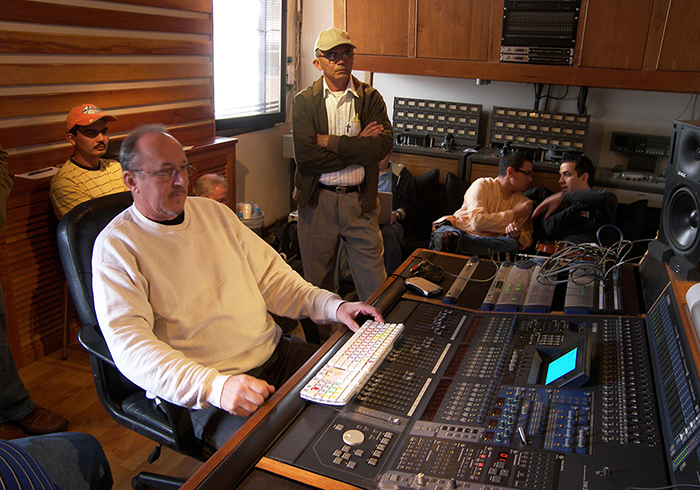“Architectural acoustical services encompass investigating, problem identification and solving, and designing solutions for matters dealing with sound and vibration in buildings.”
—The Architect’s Handbook of Professional Practice
Recording studios run the gamut from spaces designed by specialists to the vernacular and homebrew. At the high end, considerable expense might be absorbed in building a commercial studio for recording everything from a simple voice up to a full orchestra. Some studios may be designed only for post-production critical listening while mixing, editing, or mastering.
In simple terms, a recording studio consists of a tracking room (and maybe isolation booths) where the musicians play, a control room where the engineers and producers capture the sound, and a machine room for computers and other noise-generating equipment. Some might not have the “luxury” of a machine room, and some home spaces might have all in the same room. In all cases, it is desirable to keep out external sound. Walls, doors, floors, and ceilings all have a value called a Sound Transmission Class (STC) rating indicating how much airborne external noise is kept out. Inside the studio, sound is controlled by reflection, diffusion, and absorption. Too much reflection creates unwanted echoes; custom-made panels which diffuse sound without total absorption help attenuate reflections without necessarily absorbing sound and create a desirable “live” room. Too much absorption makes for “dead” spaces.

For Smithsonian Folkways Recordings, the studios we use are generally selected based on location, functionality, availability, and cost. We have used studios with a single tracking room and control room such as Jazzmania in Caracas, Venezuela (for ¡Y Que Viva Venezuela! Maestros del Joropo Oriental and ¡Parranda! Venezuelan Carnival Music). In such cases, it is essential to use “gobos” (portable sound baffles) and careful placement of musicians relative to each other.
Similarly, we used Bluecat Studio in San Antonio, a single-tracking room plus control room with minimal separation, for Los Texmaniacs, Los Tres Reyes, and Flaco and Max. For Tres Reyes, acoustic guitars and vocals were tracked together for comfort of the musicians and expedience. However, fixing an individual part in post-production such as vocal or guitar became a challenge due to cross-track “bleed” (guitar in the vocal track and vice versa). For Los Texmaniacs and Flaco and Max, drums, accordion, bajo sexto, and electric bass were tracked together in the same room with some baffling around the accordion, achieving pretty clean tracks. Then the bajo sexto was re-tracked acoustically and vocals overdubbed.
Omar Geles’ Studio in Valledupar, Colombia, was built specifically for recording vallenato folk music. Aside from the control room, there is one main room where each of the accordionists played and cabinas or isolation booths: one for guacaracha (a rasp percussion instrument), one for caja (drum), and one for an acoustic guitar. With electric bass plugged in direct in the control room plus someone singing a “scratch” track from the control room, everything was tracked at once and vocals overdubbed afterward. We pushed the envelope a bit by adding congas, but we were able to track them simultaneously by setting up in an airlock between the studio and the lounge.
A caution regarding isolation booths and even main rooms: they all have a particular “tone” unless built dead. If you don’t want that room tone on your track, don’t record in it. With dead rooms or large rooms with good acoustical treatment, room tone is less evident, and the “environment” can be created in mixing through the judicious use of such effects as digital reverb and delay. A room’s tone is not necessarily a negative thing. It can be desirable. In the 1960s it was common for pop artists to record all together in the same room, and certain studios such as Abbey Road were known for their signature sound. Newly released Smithsonian Folkways recording New Orleans Brass Bands: Through the Streets of the City was recorded in a large room at Piety Street Studio in New Orleans using a microphone setup called a “Decca Tree” (named for the Decca Records engineers who developed it) to pick up the entire band, plus spot microphones on instruments.

One of the first recordings I did for Smithsonian Folkways was not recorded in a studio at all. For The Bahamas: Islands of Song, I brought microphones, an early eight-channel digital recorder, a two-track DAT recorder, stands, and cables to Nassau. Kayla Edwards, then deputy director of the Ministry of Youth and Culture, arranged for a room in a hotel for the recording, but the ventilation system made for too much ambient noise. Kayla then arranged for a dance school where I hung quilts and other soft goods to cut down on reflections, but Kayla’s boss told us we couldn’t stop dance classes.
So we ended up at The Culture Club, a bar run by the The Baha Men, well before their big hit, “Who Let the Dogs Out?” There I was allowed to unplug beer coolers and refrigerators while we recorded, and there was little external noise coming into the building. Alas, my eight-channel recorder succumbed to the humidity, and I was forced to record direct to stereo on the fly. By grouping the artists in a snug corner of the bar and moving the all-encompassing junkanoo drum as far from the others as I could get it, we succeeded in our makeshift studio.
While studios certainly differ one from the next, the objective is always the same: to achieve the best possible recording. In that it is of the highest importance that the artists are comfortable in the space.
Pete Reiniger is the sound production supervisor and chief engineer for Smithsonian Folkways Recordings.


